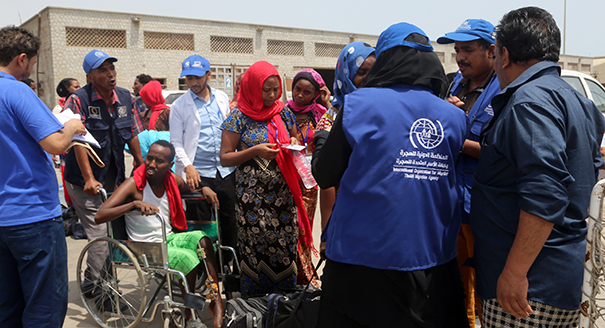Despite the catastrophic situation in Yemen, the flow of African migrants to the country fleeing violence or economic hardship at home continues. The number has been on the rise since the war began in 2015, and is higher than during the prewar years. Most of the migrants come from the Horn of Africa, and in 2018 alone their numbers jumped to 150,000, from 100,000 migrants in 2017.
Networks of traffickers have taken advantage of the lack of security measures along Yemen’s maritime borders to increase the transport of illegal migrants. The traffickers have become more organized on both the African and Yemeni sides, and dozens of migrants arrive in Yemen on a daily basis. The journey takes around eighteen to 24 hours depending on weather conditions and the state of the vessels. Due to competition among traffickers, the fees are very cheap. It costs between $170 and $200 to be taken to Yemen from Africa, and migrants can pay upon arrival. However, they are not allowed to go free until they pay the full amount due, otherwise they may be imprisoned in detention centers managed by the traffickers.
Lower prices may be a key reason for why migrants choose to go to Yemen, as paying to migrate to Europe costs a great deal more money. The journey of most migrants begins in Somalia’s port city of Bosaso and carries them to Yemeni coastal areas mostly in Hadhramawt, Abyan, or Shabwa Governorates, most of which are tribal areas. Before the conflict there was another route, toward Yemen’s Mocha. But when the Yemeni conflict extended to western coastal areas, the traffickers had to reroute their ships because the western costal zones fell under the control of armed groups allied with the Saudi-led coalition. These groups sought to combat illegal migration and prevent migrants from moving toward the border with Saudi Arabia.
Although traveling through sparsely inhabited tribal zones is difficult, as most of the journey takes place in the desert, migrants benefit in unexpected ways from this route. The tribes of Hadhramawt, Abyan, or Shabwa have traditions obliging them to offer food and accommodations to people passing through their areas. Furthermore, the road through these governorates is relatively safer than the one through more northerly areas where fighting is taking place.
Upon arrival in Yemen, most migrants do not immediately continue to their final destination. Instead, they often spend some time in the country to learn more about the trafficking routes. At the same time, they start working to earn more money to be able to pay for the rest of their passage inland, toward such places as Saudi Arabia or Oman. According to the International Organization for Migration (IOM), 99.9, percent of migrants tracked in Yemen in 2017 intended to go to Saudi Arabia. Although it is difficult for one to find work in Yemen, many of the migrants work for very low wages in farming or construction, where they can earn around $5 a day.
Crossing the Yemen-Saudi Arabia border is the most difficult part in the migrants’ journey. The 1,400-kilometer border strip has been militarized since the Yemen war began in 2015, and Saudi Arabia has reinforced border security by sending thousands of soldiers to the area. Moreover, the Saudi authorities are working with border communities to prevent migrants from entering the kingdom. Despite such security measures, however, traffickers continue to find ways to circumvent the restrictions.
The numbers of Somali migrants have declined in the last four years, given that their primary destination remains Europe. Many have relatives who have made it to the continent, and therefore prefer to take routes through the Mediterranean. In contrast, the number of illegal Ethiopian migrants to Yemen has increased and represents a majority today. According to the IOM, 92 percent of African migrants to Yemen are Ethiopian, with Somalis coming second.
Circumstances have forced Ethiopians to rely more on traffickers to get into Yemen. That is because in 2013 Saudi Arabia officially stopped accepting Ethiopian laborers following clashes between the Saudi security forces and Ethiopian workers in Jeddah and Riyadh. Ethiopians can easily find jobs as domestic workers in the kingdom, as there has been an acute shortage since those clashes. Moreover, the fact that Saudis spend around $13.7 billion on domestic workers per year, according to official Saudi statistics, encourages migrants.
While waiting for the proper circumstances to cross into Saudi Arabia, many migrants end up relying on humanitarian assistance provided by international nongovernmental organizations in refugee camps in Yemen. These camps lack basic services to receive large numbers of people, and humanitarian workers are facing difficulties in delivering food supplies to them.
The human rights of illegal migrants have also been frequently violated by the parties on the ground. In April 2018, dozens of migrants were tortured and raped by government officials after being put in detention camps in Aden. Elsewhere, armed groups have forced migrants to pay money in order to pass through their checkpoints. Such abuses have pushed many migrants to earn money by fighting as mercenaries in the Yemeni conflict. For example, in recent years the Houthis announced the death of several African fighters who had fought with them in the Yemen-Saudi Arabia border region. According to local sources, some migrants have disappeared in the mountainous areas of Shabwa, Abyan, and Bayda and are believed to have been recruited by Al-Qa‘eda in the Arabian Peninsula.
Despite the hardships and abuses illegal migrants face, they continue to arrive in Yemen looking for a better life that can help extricate them from poverty and deprivation. Here is an unhappy case of people leaping from the frying pan into the fire, but all the signs are that such migration will continue, whatever the cost.







